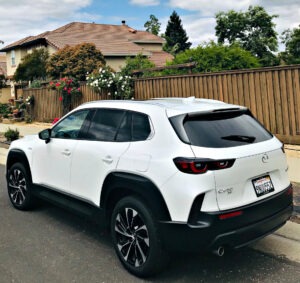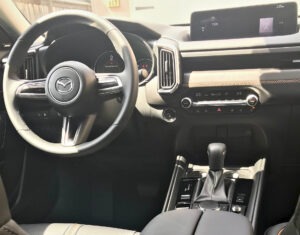Introduced by Mazda roughly three years ago, the slightly larger CX-50 was considered an upgrade to the existing CX-5 SUV.

The additional vehicle gave Mazda buyers another reason to stay put when shopping for a compact SUV. This year, a third reason to remain in the company’s sales lot was added – the unveiling of the 2025 Mazda CX-50 hybrid.
Now armed with three compact SUVs, Mazda has improved its chances when stacked up against some the best in the class. Its rivals include the Honda CR-V, Ford Escape, Nissan Rogue, Toyota RAV4, Kia Sportage, Subaru Forester, and Volkswagen Tiguan.
Although the CX-50 and its hybrid sibling have some nearly identical traits – interior makeup, driving experience, overall design – there’s two primary reasons for going with the hybrid. Like many gas-powered SUVs, the CX-50 can’t match the hybrid’s fuel efficiency and performance. The hybrid has one engine only, while the CX-50 has an optional version that’s turbocharged.
It also needs to be mentioned that the CX-50 hybrid costs more, starting at an estimated $33,900, while the gas-powered model lists for approximately $30,300. One other notable difference between the two is the CX-50 has a more rugged exterior and is off-road-ready, while the hybrid is not.
The CX-50 hybrid combines three electric motors with a 2.5-liter, four-cylinder that delivers an output of 219 horsepower and 163 pound-feet of torque. It goes 0-60 mph in 7.6 seconds (the CX-50 is clocked at 8.0 seconds). The major difference is fuel economy, where the hybrid shines at 37-39 mpg and the regular CX-50 gets only 24-31 mpg.
Both SUVs are equipped with standard all-wheel drive in all trim models. However, there is a difference. The hybrid has electric all-wheel drive (e-AWD) that directs power to the front and rear axles, eliminating the need for a physical driveshaft that the CX-50 possesses. Note the hybrid uses a continuously variable transmission (CVT) and the regular CX-50 employs a six-speed automatic transmission.

The hybrid can replicate the driving acumen of the agile CX-50, providing athletic handling that makes it fun to drive on challenging roads and appropriately safe in winding neighborhood streets. The hybrid corners well and is stable and secure.
Standard driver safety features for the hybrid include blind-spot monitoring, lane-keep assist, rain-sensing windshield wipers, rear cross traffic alert, adaptive cruise control, and forward automatic emergency braking.
AT A GLANCE – 2025 MAZDA CX-50 HYBRID
- Performance: three electric motors, 2.5-liter, four-cylinder engine, 219 horsepower
- Mileage estimate: 37-39 mpg
- Price estimate: $33,900 to $40,100
- Warranty: 3 years/36,000 miles; drivetrain: 5 years/60,000 miles; roadside assistance: 3 years/36,000; corrosion: 5 years/unlimited; battery: 8-year/100,000-miles
The hybrid interior has a nice feel, thanks in part to soft padding on the dash and very few hard surfaces. Standard features include synthetic leather upholstery, heated front seats, Apple CarPlay and Android Auto integration, and wireless connectivity on all trims. The 10.3-inch touchscreen is intuitive and comes with buttons and knobs, instead of linking everything to the touchscreen.
Seating is roomy in both CX-50 SUVs. Because of the battery’s location, the cargo area behind the rear seats is slightly less in the hybrid – 2 inches shorter at 29.2 cubic feet. With the rear seats folded to the floor, the space expands to 56.3 cubes, about average for a compact hybrid SUV.
Mazda continues to enhance its reputation for manufacturing fine SUVs. The new 2025 Mazda CX-50 hybrid is a compact SUV that has a lot of fine qualities and instantly can compete with some notable competition.
Weidel on Wheels is featured regularly on www.tahoeskiworld.com. Auto writer Jeffrey Weidel can be reached at [email protected]. Follow him on Twitter at @jeffweidel.